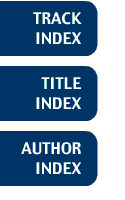
Track: Ecology, Conservation, and Archaeology
Making Information More Accessible: The Wilderness Society and the Sierra Nevada Ecosystem Project Report

Mark WilbertIn the summer of 1996 the report of the Sierra Nevada Ecosystem Project (SNEP) was released. This federally mandated study is the work of over 100 scientists bringing their individual expertise to bear on the task of assessing the current state of the entire Sierra Nevada region. It presents a detailed look at many of the complex aspects of this ecosystem biological, physical, and cultural. SNEP's work is chronicled not only in text, tables, and hard copy maps, but through approximately 150 GIS coverages. The Wilderness Society (TWS), a national conservation organization, applauded SNEP as a significant step toward understanding the complex relationships at work in the Sierra. At the same time we anticipated two problems. First, that the federal land management agencies active in the Sierra would be reluctant to utilize SNEP's scientific information, and, second, that the four volume, 3,000+ page SNEP report would need to be summarized to be of practical use to the many small community-based organizations that would be interested in its contents. As a result, TWS focused its expertise in ecology, economics, policy analysis, and GIS on the task of educating both the federal agencies and the broader public about the information in the SNEP report and the importance in seeing that the information was incorporated into land management policy. We produced a 100-page Citizen's Guide to the Sierra Nevada Ecosystem Project Report and presented it in workshops throughout the Sierra. The Center for Landscape Analysis (CLA) is TWS's GIS and remote sensing group. CLA's goals in this project were (1) to acquire SNEP data and metadata in order to create our own maps that would provide greater utility than those in the SNEP report, (2) to make SNEP data easily available to others with less sophisticated GIS capability, and (3) to provide analytical support to TWS's advocacy of SNEP. To these ends we have prepared a series of maps at the Forest Service recreation map scale that highlight the three map-based reserve systems proposed by SNEP. We have also prepared ArcView GIS project and shapefiles that allow easy viewing of both SNEP data and county economic profiles compiled by TWS. Finally, we presented these maps and shapefiles, along with the Citizen's Guide, to interested groups throughout the Sierra. The result has been an important increase in the discussion of the valuable information in SNEP and the use of SNEP data in several efforts to protect specific threatened wildland areas.
Mark Wilbert
The Wilderness Society
1424 Fourth Ave
Seattle, WA 98101
USA
Telephone: 206-624-6430
Fax: 206-624-7101
E-mail: mwilbert@twsnw.org